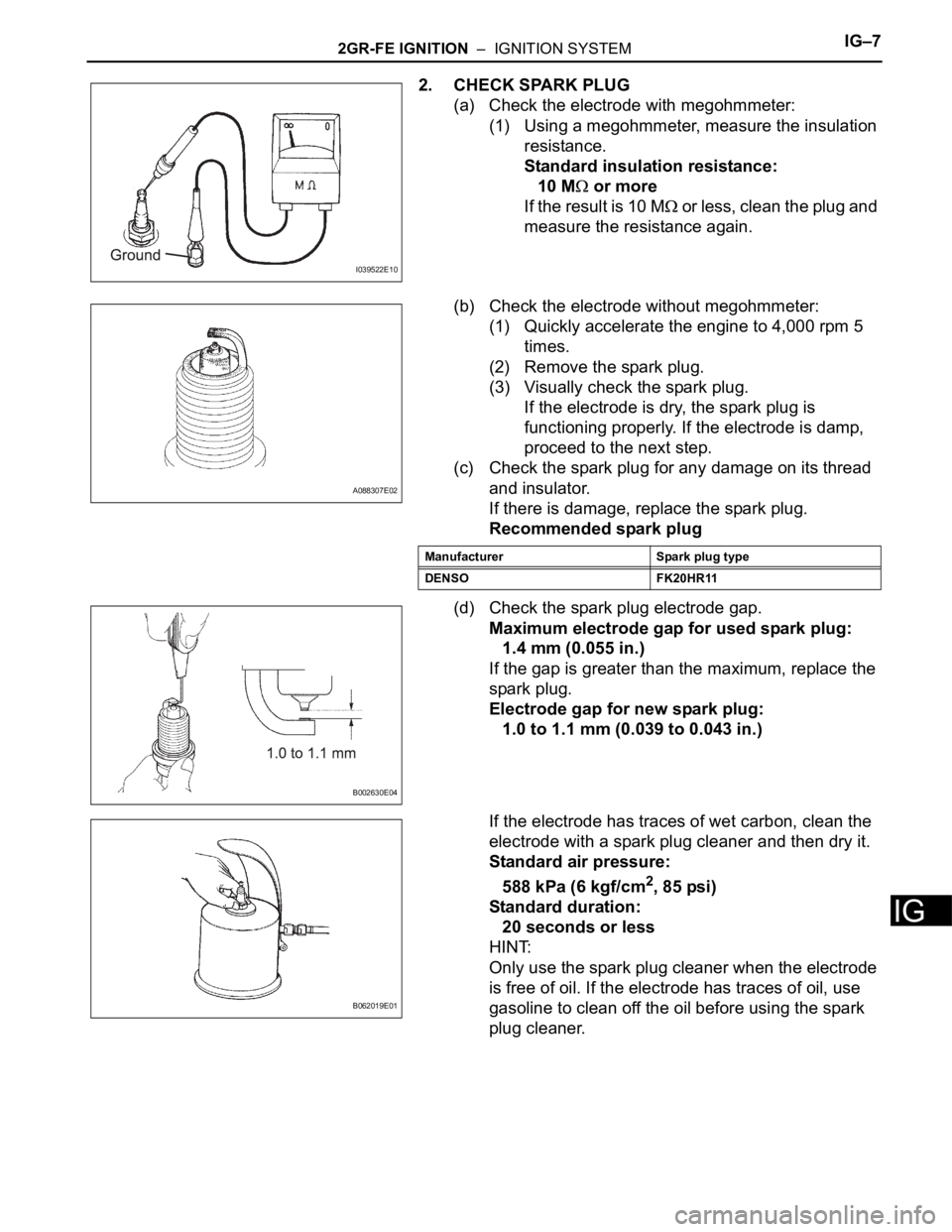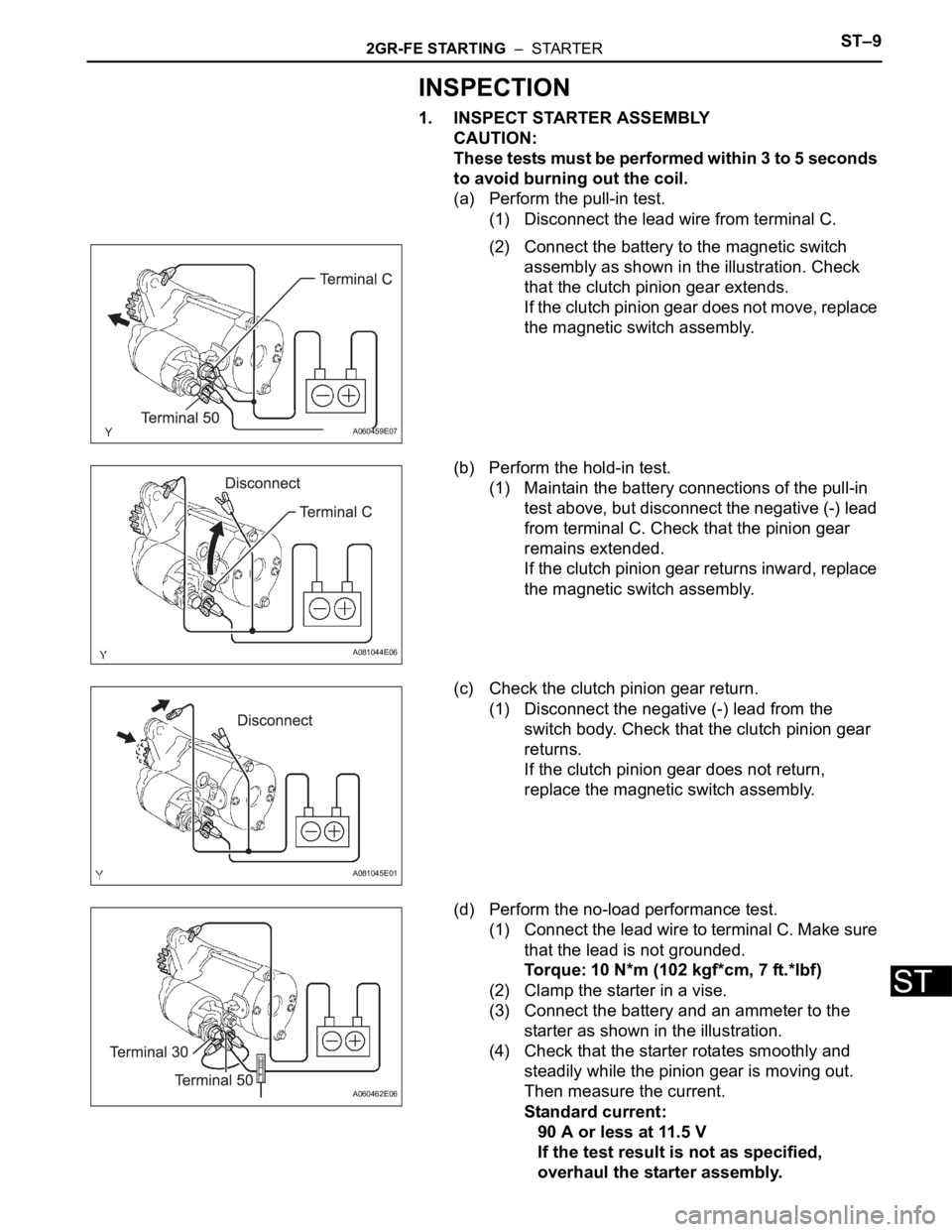Page 884 of 2000
LU–242GR-FE LUBRICATION – OIL PUMP
LU
(b) Install the dipstick guide with the bolt.
Torque: 21 N*m (214 kgf*cm, 15 ft.*lbf)
14. INSTALL NO. 2 OIL DIPSTICK GUIDE
(a) Install a new O-ring to the dipstick guide.
(b) Install the dipstick guide with the bolt.
Torque: 21 N*m (214 kgf*cm, 15 ft.*lbf)
(c) Install the oil dipstick.
15. REMOVE ENGINE FROM STAND
16. INSTALL ENGINE ASSEMBLY
(a) Install the engine to the vehicle (see page EM-31).
17. CONNECT CABLE TO NEGATIVE BATTERY
TERMINAL
A132180
A132179
Page 895 of 2000

2GR-FE IGNITION – IGNITION SYSTEMIG–5
IG
ON-VEHICLE INSPECTION
1. CHECK IGNITION COIL ASSEMBLY AND PERFORM
SPARK TEST
NOTICE:
In this section, the terms "Cold" and "Hot" refer to
the temperature of the sensor. "Cold" means
approximately -10 to 50
C (14 to 122F). "Hot" means
approximately 50 to 100
C (122 to 212F).
(a) Check the DTCs.
NOTICE:
If a DTC is present, perform troubleshooting in
accordance with the procedure for that DTC.
(b) Check that sparks occur.
(1) Remove the V-bank cover.
(2) Remove the intake air surge tank (see page
EM-27).
(3) Remove the bolt and ignition coil.
(4) Using a 16 mm spark plug wrench, remove the
spark plug.
(5) Disconnect the 6 fuel injector connectors.
(6) Install the spark plug into the ignition coil, and
then connect the ignition coil connectors.
(7) Ground the spark plug.
(8) Check that sparks occur at the spark plug while
the engine is being cranked.
NOTICE:
• Be sure to ground the spark plugs when
checking them.
• If the ignition coil has been struck or
dropped, replace it.
• Do not crank the engine for more than 2
seconds.
If sparks do not occur, perform troubleshooting
using the spark test flowchart.
(9) Using a 16 mm plug wrench, install the spark
plug.
Torque: 25 N*m (254 kgf*cm, 18 ft.*lbf)
(10) Install the ignition coil with the bolt.
Torque: 10 N*m (102 kgf*cm, 7 ft.*lbf)
(11) Connect the 6 fuel injector connectors.
(12) Install the intake air surge tank (see page EM-
34).
(13) Install the V-bank cover.
A136823
A136826
Page 896 of 2000

IG–62GR-FE IGNITION – IGNITION SYSTEM
IG
(c) Perform troubleshooting using the spark test
flowchart.
(1) Check that the ignition coil connector is
securely connected.
Result
(2) Perform the spark test on each ignition coil.
1. Replace the ignition coil with a normal one.
2. Perform the spark test again.
Result
(3) Check the power supply to the ignition coil.
1. Disconnect the ignition coil connector.
2. Turn the ignition switch ON.
3. Measure the voltage of the wire harness
side connector.
Standard voltage
Result
(4) Check the resistance of the crankshaft position
sensor.
Standard resistance
Result
(5) Check the IGT signal from the ECM.
Result
Result Proceed to
NG Connect securely
OK Go to next step
Result Proceed to
OK Replace ignition coil
NG Go to next step
A136824
Tester Connection Specified Condition
1 (+B) - 4 (GND) 9 to 14 V
Result Proceed to
NG Check wire harness and connector
OK Go to next step
Temperature Condition Specified Condition
Cold 1,630 to 2,740
Hot 2,065 to 3,225
Result Proceed to
NG Replace crankshaft position sensor
OK Go to next step
Result Proceed to
NG Check ECM (see page ES-220)
OK Repair wiring between ignition coil and
ECM
Page 897 of 2000

2GR-FE IGNITION – IGNITION SYSTEMIG–7
IG
2. CHECK SPARK PLUG
(a) Check the electrode with megohmmeter:
(1) Using a megohmmeter, measure the insulation
resistance.
Standard insulation resistance:
10 M
or more
If the result is 10 M
or less, clean the plug and
measure the resistance again.
(b) Check the electrode without megohmmeter:
(1) Quickly accelerate the engine to 4,000 rpm 5
times.
(2) Remove the spark plug.
(3) Visually check the spark plug.
If the electrode is dry, the spark plug is
functioning properly. If the electrode is damp,
proceed to the next step.
(c) Check the spark plug for any damage on its thread
and insulator.
If there is damage, replace the spark plug.
Recommended spark plug
(d) Check the spark plug electrode gap.
Maximum electrode gap for used spark plug:
1.4 mm (0.055 in.)
If the gap is greater than the maximum, replace the
spark plug.
Electrode gap for new spark plug:
1.0 to 1.1 mm (0.039 to 0.043 in.)
If the electrode has traces of wet carbon, clean the
electrode with a spark plug cleaner and then dry it.
Standard air pressure:
588 kPa (6 kgf/cm
2, 85 psi)
Standard duration:
20 seconds or less
HINT:
Only use the spark plug cleaner when the electrode
is free of oil. If the electrode has traces of oil, use
gasoline to clean off the oil before using the spark
plug cleaner.
I039522E10
A088307E02
Manufacturer Spark plug type
DENSO FK20HR11
B002630E04
B062019E01
Page 909 of 2000
ST–62GR-FE STARTING – STARTER
ST
REMOVAL
1. DISCONNECT CABLE FROM NEGATIVE BATTERY
TERMINAL
CAUTION:
Wait at least 90 seconds after disconnecting the
cable from the negative (-) battery terminal to
prevent airbag and seat belt pretensioner activation.
2. REMOVE BATTERY CLAMP SUB-ASSEMBLY
(a) Loosen the bolt and nut, and remove the battery
clamp.
3. REMOVE BATTERY INSULATOR
4. REMOVE BATTERY
5. REMOVE BATTERY TRAY
6. REMOVE FRONT BATTERY CARRIER
(a) Disconnect the 2 clamps of the engine wire.
(b) Remove the 4 bolts and front battery carrier.
7. REMOVE BATTERY BRACKET REINFORCEMENT
(a) Remove the 2 bolts and battery bracket
reinforcement.
8. REMOVE STARTER ASSEMBLY
(a) Disconnect the starter connector.
(b) Open the terminal cap, remove the nut and
disconnect the starter wire.
A124827
A124828
A126954
Page 910 of 2000
2GR-FE STARTING – STARTERST–7
ST
(c) Remove the 2 bolts and starter.
DISASSEMBLY
1. REMOVE MAGNETIC SWITCH ASSEMBLY
(a) Remove the nut and disconnect the lead wire from
the magnetic switch assembly.
(b) Remove the 2 screws holding the magnetic switch
assembly to the starter drive housing assembly.
(c) Remove the magnetic switch assembly.
(d) Remove the return spring and plunger from the
starter drive housing assembly.
2. REMOVE STARTER YOKE ASSEMBLY
(a) Remove the 2 through-bolts, and pull out the starter
yoke assembly together with the starter commutator
end frame assembly.
3. REMOVE STARTER COMMUTATOR END FRAME
ASSEMBLY
(a) Remove the starter commutator end frame
assembly from the starter yoke assembly.
A126955
A079718E01
A079719E01
A079720E01
A079721E01
Page 911 of 2000
ST–82GR-FE STARTING – STARTER
ST
4. REMOVE STARTER ARMATURE PLATE
(a) Remove the starter armature plate from the starter
yoke assembly.
5. REMOVE STARTER COMMUTATOR END FRAME
COVER
(a) Using a screwdriver, pry out the starter commutator
end frame cover.
6. REMOVE STARTER ARMATURE ASSEMBLY
(a) Using snap ring pliers, remove the snap ring and
plate washer.
(b) Remove the starter armature assembly from the
starter commutator end frame assembly.
7. REMOVE PLANETARY GEAR
(a) Remove the 3 planetary gears from the starter drive
housing assembly.
A079722E01
A079723E01
A082440E03
A081167E01
Page 912 of 2000

2GR-FE STARTING – STARTERST–9
ST
INSPECTION
1. INSPECT STARTER ASSEMBLY
CAUTION:
These tests must be performed within 3 to 5 seconds
to avoid burning out the coil.
(a) Perform the pull-in test.
(1) Disconnect the lead wire from terminal C.
(2) Connect the battery to the magnetic switch
assembly as shown in the illustration. Check
that the clutch pinion gear extends.
If the clutch pinion gear does not move, replace
the magnetic switch assembly.
(b) Perform the hold-in test.
(1) Maintain the battery connections of the pull-in
test above, but disconnect the negative (-) lead
from terminal C. Check that the pinion gear
remains extended.
If the clutch pinion gear returns inward, replace
the magnetic switch assembly.
(c) Check the clutch pinion gear return.
(1) Disconnect the negative (-) lead from the
switch body. Check that the clutch pinion gear
returns.
If the clutch pinion gear does not return,
replace the magnetic switch assembly.
(d) Perform the no-load performance test.
(1) Connect the lead wire to terminal C. Make sure
that the lead is not grounded.
Torque: 10 N*m (102 kgf*cm, 7 ft.*lbf)
(2) Clamp the starter in a vise.
(3) Connect the battery and an ammeter to the
starter as shown in the illustration.
(4) Check that the starter rotates smoothly and
steadily while the pinion gear is moving out.
Then measure the current.
Standard current:
90 A or less at 11.5 V
If the test result is not as specified,
overhaul the starter assembly.
A060459E07
A081044E06
A081045E01
A060462E06